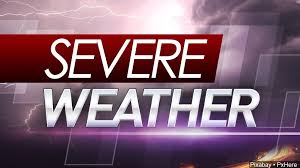
Stay weather aware during severe storm season
Dickinson County was ‘in the bullseye’ on April 29
By Kathy Hageman/Dickinson County Public Information coordinator
Until last week, Dickinson County had not had significant precipitation for months, leading to untold numbers of wildfires and numerous burn bans.
But that curse turned out to be a blessing when the lack of moisture in the ground saved the area from a severe tornado outbreak in the late afternoon hours of Friday, April 29. The same weather conditions led to the formation of the EF3 tornado that struck Andover.
“Talking to the meteorologists, the thing that made us super lucky was we didn’t have any moisture in the ground,” said Dickinson County Emergency Management Director Chancy Smith. “Had we had two or three inches of rain before that weather broke out, it could have been bad. Never in my 17 years of doing this job have I ever seen an outbreak like this,” Smith said. “Usually one front will go through and you’re done. It’s usually not front after front with supercell tornadoes.”
As it was, two tornadoes touched down, along with hail that varied from pea to grapefruit size, causing damage to outbuildings, windows and roofs.
“We had six tornadoes or funnel clouds going on at the same time in the county. If we had that moisture it would have been intense,” Smith said. “Just imagine if we had six EF3 tornadoes on the ground tearing stuff up.”
Warning systems
That volatile situation is a good reminder for anyone in Kansas to stay aware of weather conditions, not only in the summer months but any time of year.
On April 29, storm sirens were sounded several times in the affected Dickinson County communities.
Smith noted that storm sirens are outdoor warning devices intended to alert people that a dangerous situation exists.
“Whether that danger is a tornado or softball size hail, there’s danger outside,” he said.
The sirens typically are tested each Tuesday at noon during severe weather season.
Dickinson County residents need to know that no “all clear” siren is ever sounded.
“So, if you hear a siren that means there’s danger. Take shelter,” he said.
Also, people need to have another way to get alerts, whether that be a regular radio, weather radio, a phone weather app, or some other method.
Radar not always accurate
Dickinson County relies heavily on trained storm spotters to provide information about what’s happening on the ground, supplementing information provided by the National Weather Service.
Spotter reports are especially important since Dickinson County has the misfortune of being on the far reaches of each of the three radars originating from the Topeka, Wichita and Hastings weather service offices.
“Their radars are far enough away from us and the earth is round so when the radar shoots out on a straight line following the curvature of the earth they cannot see us here on the surface,” Smith said during an interview in May 2020.
“Maybe 5,000 feet is the lowest they can see so they rely on the upper levels of the atmosphere to tell them what’s going on at the lower levels. If there’s rotation at the upper level there’s going to be rotation at the lower level, but there can be rotation at the lower level without rotation at the upper level so we could have a tornado on the ground and they’d (NWS) never see it,” Smith said.
Weather services notify early
Dickinson County is served by the National Weather Service Office in Topeka so that entity had already sent out notifications about the likelihood of severe weather on April 29.
What was unusual, Smith said, was he also received notices from the National Weather Service offices in Wichita and Hastings, Neb.
“I sometimes get one from Wichita, but I’ve never gotten one from Hastings – ever,” Smith said. “That should have let me know they thought we were in the bullseye for something. But that’s exactly what their (weather) models showed. The storms were all developing over Dickinson County.”
Smith said the southern portion of the county was ripe for tornado development because it had received more moisture in weeks prior to the storm. Then with temperatures reaching 90 degrees that day, the heat pulled the moisture out of the ground creating humidity.
Busy evening
Storms began firing up in Dickinson County around 5:30 p.m. on April 29, and Smith, along with his intern, Josh Walker, headed south of Abilene to storm spot at Rural Center Elementary School at Kansas Highway 15 and 1400 Avenue.
From there they watched two funnel clouds. One of those was actually touching the ground.
“From 5,000 feet in the air to the ground you couldn’t see anything, but 20 feet off the ground it was a black swirling mess and the middle was invisible,” Smith said.
That evening, Smith and Walker followed funnel clouds from Rural Center school over to the outskirts of Chapman three times. Storms were firing up near the Carlton area, which is where the dry line ended.
Returning to Rural Center after the third time, they moved to 1200 and Eden Road to check out a debris path and then heard on the radio that a large wedge tornado was on the ground just west of Herington Lake. They stopped at several houses. One had tree damage and some broken windows.
Storm chasers
In the past 15 years or so, storm chasers from all over the United States and other areas of the world, are out on the highways during threatening weather.
Based on streaming information coming from the cameras in their vehicles, Smith referred to a screen shot which showed hundreds of red dots indicating a broadcast signal.
“At 6:37 p.m. there are six tornadoes in Dickinson County and all those dots are watching the tornadoes. I’d say there were 200 storm chasers out there,” he said.
In recent years, members of the public have joined the ranks of storm chasers, recording video.
“On social media you could see all these posts from people who were out videotaping, but that rotating cloud in the sky can be on the ground destroying stuff in a matter of seconds. It makes good video, but it’s so dangerous to do that,” Smith said.
“It’s the stuff that tornadoes throw around that kills people – cars, plywood. Imagine it picking up a brick and throwing it across the sky. If it hits you at 110 miles an hour, you’re dead.”













